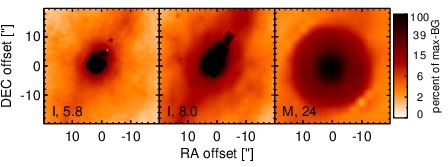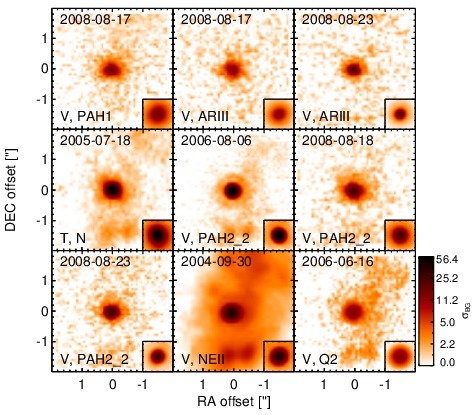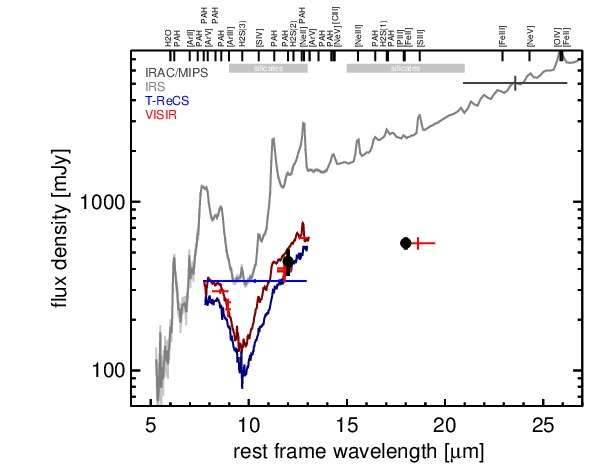Sasmirala Individual Information for NGC 7582
Description
NGC 7582 is a highly inclined barred spiral galaxy at a distance of D = 23 ± 4.6 Mpc [springob_erratum:_2009] with an obscured AGN surrounded by a powerful star formation disc (major axis diameter~ 4arcsec ~ 0.4 kpc) and a dust lane crossing over the nucleus [morris_velocity_1985, regan_using_1999, riffel_agn-starburst_2009]. The AGN belongs to nine-month BAT AGN sample and has complex X-ray source with varying obscuration (e.g. [piconcelli_xmm-newton_2007, bianchi_how_2009]). The optical nuclear spectrum is a superposition of a Sy 2 and a starburst, hence we treat it as an AGN/starburst composite [veron_agns_1997]. Transitional broad emission lines were observed [aretxaga_seyfert_1999], in agreement with the varying obscuration scenario. The nucleus appears as a weak compact source embedded within extended starburst-related emission at radio wavelengths with arcsecond resolution [ulvestad_radio_1984, morganti_radio_1999, thean_high-resolution_2000]. It features a one-sided kiloparsec-scale [O III] ionization cone to the south-west (PA~ 250∘; [morris_velocity_1985, storchi-bergmann_detection_1991]). Pioneering ground-based MIR observations of NGC 7582 were performed by [frogel_8-13_1982] and [glass_mid-infrared_1982], followed by [roche_8-13_1984, roche_atlas_1991]. The first subarcsecond-resolution MIR images were taken with ESO 3.6 m/TIMMI2 [siebenmorgen_mid-infrared_2004, raban_core_2008] and CTIO 4 m/OSCIR [ramos_almeida_infrared_2009] and show a compact nucleus embedded within complex extended emission mainly along the north-south direction (diameter~ 4arcsec ~ 0.4 kpc). NGC 7582 was also observed with the space-based ISO [genzel_what_1998, radovich_10-200_1999, rigopoulou_large_1999] and Spitzer/IRAC, IRS and MIPS. The corresponding IRAC and MIPS images are dominated by a very bright extended nucleus comprising AGN and starburst emission, which outshines the remaining spiral-like host emission. The IRAC 5.8 and 8.0 μm post-BCD images are saturated and, thus, not used (but see [gallimore_infrared_2010]). The IRS LR starring-mode spectrum exhibits deep silicate 10 μm absorption, bright PAH features, and a steep red spectral slope in νFν-space (see also [wu_spitzer/irs_2009, tommasin_spitzer-irs_2010, gallimore_infrared_2010]). Thus, the arcsecond-scale MIR SED is consistent with the dual AGN/starburst nature of NGC 7582. Its nuclear region was observed with VISIR in four different N-band and one Q-band filter images, HR [Ne II] spectra, and a LR N-band spectrum, all obtained between 2004 and 2008 [wold_nuclear_2006-1, wold_nuclear_2006, honig_dusty_2010-1, reunanen_vlt_2010]. In addition, a broad N filter image (unpublished, to our knowledge) and a LR N-band spectrum [gonzalez-martin_dust_2013] were obtained with T-ReCS in 2005. A compact nucleus, embedded within extended emission on < 3σ level, was detected in all images. In the sharpest image (PAH2_2 from 2006), the nucleus is unresolved, while it appears to be marginally resolved in several other cases (PA~ 80∘). Therefore, we classify the nucleus as generally unresolved in the MIR at subarcsecond resolution. The extended emission is best visible in the longest-wavelength images. It extends ~ 1.5 ~ 170 pc to the south with two bright emission knots (PA~ 175∘ and ~ 197∘, respectively), and ~ 2arcsec ~ 220 pc to the north-west with several knotty features (PA~-26∘; see [wold_nuclear_2006-1] for a detailed analysis). Our nuclear photometry is consistent with the previously published values [honig_dusty_2010-1, reunanen_vlt_2010], and also with the VISIR and T-ReCS spectra. The resulting nuclear MIR SED exhibits on average ~ 65% lower flux levels than the Spitzer spectrophotometry, while maintaining a deep silicate 10 μm absorption feature. We use the T-ReCS spectrum to compute the nuclear, silicate feature-corrected 12 μm continuum emission estimate. In conclusion, the silicate absorption is originating in the projected central ~ 40 pc of NGC 7582, either in the nucleus or the foreground dust lane, and the starburst dominates its total MIR emission. The nuclear MIR SED might still be affected by a minor star-formation contribution as indicated by the weak PAH 11.3 μm feature in the subarcsecond-resolution spectra. Note that NGC 7582 was unsuccessfully attempted interferometrically with MIDI [tristram_parsec-scale_2009].
- [aretxaga_seyfert_1999] Itziar Aretxaga, B. Joguet, D. Kunth, J. Melnick, and R. J. Terlevich. Seyfert 1 mutation of the classical seyfert 2 nucleus NGC 7582 . ApJL , 519 pp. L123–L126, July 1999.
- [bianchi_how_2009] Stefano Bianchi, Enrico Piconcelli, Marco Chiaberge, Elena Jiménez Bailón, Giorgio Matt, and Fabrizio Fiore. How complex is the obscuration in active galactic nuclei? new clues from the suzaku monitoring of the x-ray absorbers in NGC 7582 . ApJ , 695 pp. 781–787, April 2009.
- [frogel_8-13_1982] J. F. Frogel, J. H. Elias, and M. M. Phillips. 8-13 micron observations of nine emission-line galaxies . ApJ , 260 pp. 70–74, September 1982.
- [gallimore_infrared_2010] J. F. Gallimore, A. Yzaguirre, J. Jakoboski, M. J. Stevenosky, D. J. Axon, S. A. Baum, C. L. Buchanan, M. Elitzur, M. Elvis, C. P. O'Dea, and A. Robinson. Infrared spectral energy distributions of seyfert galaxies: Spitzer space telescope observations of the 12 μm sample of active galaxies . ApJS , 187 pp. 172–211, March 2010.
- [genzel_what_1998] R. Genzel, D. Lutz, E. Sturm, E. Egami, D. Kunze, A. F. M. Moorwood, D. Rigopoulou, H. W. W. Spoon, A. Sternberg, L. E. Tacconi-Garman, L. Tacconi, and N. Thatte. What powers ultraluminous IRAS galaxies? . ApJ , 498 pp. 579, May 1998.
- [glass_mid-infrared_1982] I. S. Glass, A. F. M. Moorwood, and W. Eichendorf. Mid-infrared observations of seyfert 1 and narrow-line x-ray galaxies . A&A , 107 pp. 276–282, March 1982.
- [gonzalez-martin_dust_2013] O. González-Martín, J. M. Rodríguez-Espinosa, T. Díaz-Santos, C. Packham, A. Alonso-Herrero, P. Esquej, C. Ramos Almeida, R. Mason, and C. Telesco. Dust in active galactic nuclei. mid-infrared t-ReCS/Gemini spectra using the new RedCan pipeline . A&A , 553 pp. 35, May 2013.
- [honig_dusty_2010-1] S. F. Hönig, M. Kishimoto, P. Gandhi, A. Smette, D. Asmus, W. Duschl, M. Polletta, and G. Weigelt. The dusty heart of nearby active galaxies. i. high-spatial resolution mid-IR spectro-photometry of seyfert galaxies . A&A , 515 pp. 23, June 2010.
- [morganti_radio_1999] R. Morganti, Z. I. Tsvetanov, J. Gallimore, and M. G. Allen. Radio continuum morphology of southern seyfert galaxies . A&AS , 137 pp. 457–471, June 1999.
- [morris_velocity_1985] S. Morris, M. Ward, M. Whittle, A. S. Wilson, and K. Taylor. The velocity fields and radio structures of the active galaxies NGC 5643 and NGC 7582 . MNRAS , 216 pp. 193–217, September 1985.
- [piconcelli_xmm-newton_2007] E. Piconcelli, S. Bianchi, M. Guainazzi, F. Fiore, and M. Chiaberge. XMM-Newton broad-band observations of NGC 7582: N\H\ variations and fading out of the active nucleus . A&A , 466 pp. 855–863, May 2007.
- [raban_core_2008] D. Raban, B. Heijligers, H. Röttgering, K. Meisenheimer, W. Jaffe, H. U. Käufl, and T. Henning. The core flux of the brightest 10 μm galaxies in the southern sky . A&A , 484 pp. 341–345, June 2008.
- [radovich_10-200_1999] M. Radovich, U. Klaas, J. Acosta-Pulido, and D. Lemke. The 10-200 MU m spectral energy distribution of the prototype narrow-line x-ray galaxy NGC 7582 . A&A , 348 pp. 705–710, August 1999.
- [ramos_almeida_infrared_2009] C. Ramos Almeida, N. A. Levenson, J. M. Rodríguez Espinosa, A. Alonso-Herrero, A. Asensio Ramos, J. T. Radomski, C. Packham, R. S. Fisher, and C. M. Telesco. The infrared nuclear emission of seyfert galaxies on parsec scales: Testing the clumpy torus models . ApJ , 702 pp. 1127–1149, September 2009.
- [regan_using_1999] Michael W. Regan and John S. Mulchaey. Using HUBBLE SPACE TELESCOPE imaging of nuclear dust morphology to rule out bars fueling seyfert nuclei . AJ , 117 pp. 2676–2694, June 1999.
- [reunanen_vlt_2010] J. Reunanen, M. A. Prieto, and R. Siebenmorgen. VLT diffraction-limited imaging at 11 and 18μm of the nearest active galactic nuclei . MNRAS , 402 pp. 879–894, February 2010.
- [riffel_agn-starburst_2009] Rogemar A. Riffel, Thaisa Storchi-Bergmann, Oli L. Dors, and Cláudia Winge. AGN-starburst connection in NGC7582: gemini near-infrared spectrograph integral field unit observations . MNRAS , 393 pp. 783–797, March 2009.
- [rigopoulou_large_1999] D. Rigopoulou, H. W. W. Spoon, R. Genzel, D. Lutz, A. F. M. Moorwood, and Q. D. Tran. A large mid-infrared spectroscopic and near-infrared imaging survey of ultraluminous infrared galaxies: Their nature and evolution . AJ , 118 pp. 2625–2645, December 1999.
- [roche_8-13_1984] P. F. Roche, B. Whitmore, D. K. Aitken, and M. M. Phillips. 8-13 micron spectrophotometry of galaxies. II - 10 seyferts and 3C 273 . MNRAS , 207 pp. 35–45, March 1984.
- [roche_atlas_1991] Patrick F. Roche, David K. Aitken, Craig H. Smith, and Martin J. Ward. An atlas of mid-infrared spectra of galaxy nuclei . MNRAS , 248 pp. 606–629, February 1991.
- [siebenmorgen_mid-infrared_2004] R. Siebenmorgen, E. Krügel, and H. W. W. Spoon. Mid-infrared emission of galactic nuclei. TIMMI2 versus ISO observations and models . A&A , 414 pp. 123–139, January 2004.
- [springob_erratum:_2009] Christopher M. Springob, Karen L. Masters, Martha P. Haynes, Riccardo Giovanelli, and Christian Marinoni. Erratum: "SFI++ II: a new i-band tully-fisher catalog, derivation of peculiar velocities and data set properties" (2007, ApJS, 172, 599) . ApJS , 182 pp. 474–475, May 2009.
- [storchi-bergmann_detection_1991] Thaisa Storchi-Bergmann and Charles J. Bonatto. Detection of a forbidden o III 5007-a radiation cone in the nuclei of NGC 1365 and 7582 . MNRAS , 250 pp. 138–143, May 1991.
- [thean_high-resolution_2000] Andy Thean, Alan Pedlar, Marek J. Kukula, Stefi A. Baum, and Christopher P. O'Dea. High-resolution radio observations of seyfert galaxies in the extended 12-μm sample - i. the observations . MNRAS , 314 pp. 573–588, May 2000.
- [tommasin_spitzer-irs_2010] Silvia Tommasin, Luigi Spinoglio, Matthew A. Malkan, and Giovanni Fazio. Spitzer-IRS high-resolution spectroscopy of the 12 μm seyfert galaxies. II. results for the complete data set . ApJ , 709 pp. 1257–1283, February 2010.
- [tristram_parsec-scale_2009] K. R. W. Tristram, D. Raban, K. Meisenheimer, W. Jaffe, H. Röttgering, L. Burtscher, W. D. Cotton, U. Graser, Th. Henning, Ch. Leinert, B. Lopez, S. Morel, G. Perrin, and M. Wittkowski. Parsec-scale dust distributions in seyfert galaxies. results of the MIDI AGN snapshot survey . A&A , 502 pp. 67–84, July 2009.
- [ulvestad_radio_1984] J. S. Ulvestad and A. S. Wilson. Radio structures of seyfert galaxies. VI - VLA observations of a nearby sample . ApJ , 285 pp. 439–452, October 1984.
- [veron_agns_1997] P. Veron, A. C. Goncalves, and M.-P. Veron-Cetty. AGNs with composite spectra. . A&A , 319 pp. 52–66, March 1997.
- [wold_nuclear_2006] M. Wold and E. Galliano. Nuclear embedded star clusters in NGC 7582* . MNRAS , 369 pp. L47–L51, June 2006.
- [wold_nuclear_2006-1] M. Wold, M. Lacy, H. U. Käufl, and R. Siebenmorgen. The nuclear regions of NGC 7582 from [ne II] spectroscopy at 12.8 μm - an estimate of the black hole mass . A&A , 460 pp. 449–457, December 2006.
- [wu_spitzer/irs_2009] Yanling Wu, Vassilis Charmandaris, Jiasheng Huang, Luigi Spinoglio, and Silvia Tommasin. Spitzer/IRS 5-35 μm low-resolution spectroscopy of the 12 μm seyfert sample . ApJ , 701 pp. 658–676, August 2009.
Images

Optical image (DSS, red filter). Displayed are the central 4 arcmin with North being up and East to the left. The colour scaling is linear with white corresponding to the median background (BG) and black to the 0.01% pixels with the highest intensity.

Spitzer MIR images. Displayed are the inner 40 arcsec with North being up and East to the left. The colour scaling is logarithmic with white corresponding to median BG and black to the 0.1% pixels with the highest intensity. The label in the bottom left states instrument and central wavelength of the filter in micron (I: IRAC, M: MIPS).

Subarcsecond-resolution MIR images sorted by increasing filter central wavelength. Displayed are the inner 4 arcsec with North being up and East to the left. The colour scaling is logarithmic with white corresponding to median BG and black to the 75% of the highest intensity of all images in units of sig_bg. The inset image (where present; either bottom or top right) shows the central arcsecond of the PSF from the calibrator star, scaled to match the science target. The labels in the bottom left state instrument and filter names (C: COMICS, M: Michelle, T: T-ReCS, V: VISIR).
SEDs


MIR SED. The description of the symbols in all the SED plots (where present) is the following: Grey crosses and solid lines mark the Spitzer/IRAC, MIPS and IRS data. The colour coding of the other symbols is as follows: green for COMICS, magenta for Michelle, blue for T-ReCS and red for VISIR data. Darker-coloured solid lines mark spectra of the corresponding instrument. The black filled circles mark the nuclear 12 and 18 micron continuum emission estimate from the data (where present). The ticks on the top axis mark positions of common MIR emission lines, while the light grey horizontal bars mark wavelength ranges affected by the silicate 10 and 18 micron features.